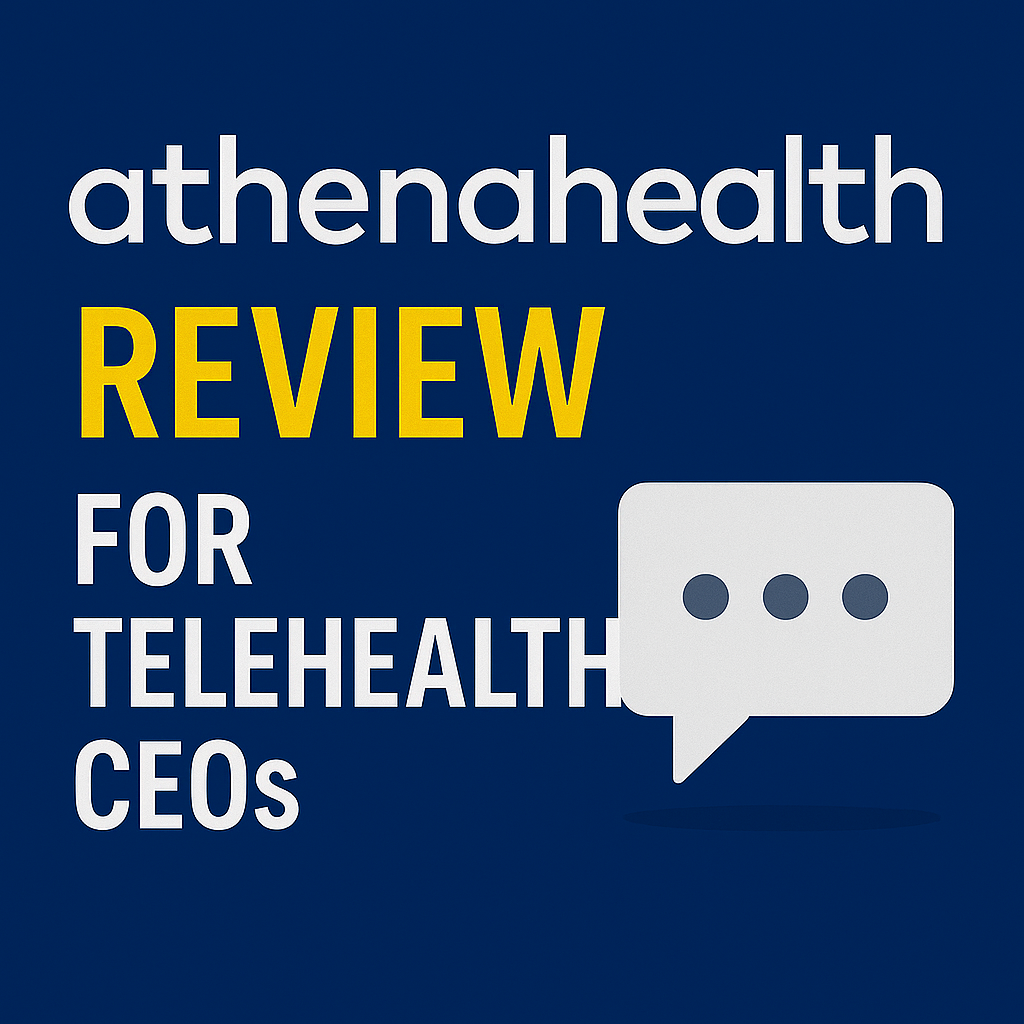Introduction: Why Telehealth Software Defines Growth
For telehealth CEOs, your software stack is more than a toolset — it’s compliance, economics, and valuation in disguise.
👉 The wrong vendor can expose you to HIPAA violations, FTC investigations, or DEA audits.
👉 The right vendor can reduce CAC, expand LTV, and make your company exit-ready.
This post reviews the best telehealth software platforms by category, with an emphasis on what CEOs, boards, and investors actually care about: compliance, integrations, pricing models, and defensibility.
Section 1: What Makes Telehealth Software “Defensible”
- HIPAA Compliance & BAA → Any vendor handling PHI must sign a Business Associate Agreement.
- Scalability → Can it grow from 1,000 to 100,000 patients?
- Integrations → EHR, pharmacy, billing, analytics.
- Pricing Model → Predictable vs fragile.
- Investor Lens → Does it support CAC/LTV economics and exit readiness?
Section 2: Best EHR / EMR Platforms
1. DrChrono
- Overview: Cloud-based EHR built for startups and mid-market telehealth.
- Strengths: Flexible API, telehealth-native workflows, HIPAA-compliant.
- Weaknesses: Can be overwhelming to configure at scale.
- Best Fit: Early-stage telehealth needing customizable EHR.
2. Athenahealth
- Overview: Enterprise EHR with strong payer connections.
- Strengths: Scalable, trusted by large health systems.
- Weaknesses: Expensive, slower to implement.
- Best Fit: Scaling telehealth with payer/employer contracts.
3. Elation Health
- Overview: Physician-focused EHR with telehealth integrations.
- Strengths: Clean interface, strong compliance.
- Weaknesses: Less enterprise-ready than Athena.
- Best Fit: Specialty telehealth practices (women’s health, concierge care).
👉 Deep Dive Reviews Coming Soon: [DrChrono Review] | [Athenahealth Review] | [Elation Health Review]
Section 3: Best Telehealth Video Platforms
1. Doxy.me
- Overview: Popular HIPAA-compliant telehealth video tool.
- Strengths: Simple, low cost, quick onboarding.
- Weaknesses: Limited customization.
- Best Fit: Small-to-mid telehealth brands.
2. Zoom for Healthcare
- Overview: Healthcare version of Zoom, with BAA + HIPAA compliance.
- Strengths: Familiar UX, scalable, robust.
- Weaknesses: Requires enterprise pricing tiers.
- Best Fit: Telehealth brands scaling beyond 50+ providers.
3. VSee
- Overview: End-to-end telehealth video + workflow tool.
- Strengths: Deeper integrations, EHR add-ons.
- Weaknesses: Steeper learning curve.
- Best Fit: Telehealth startups needing bundled workflows.
👉 Deep Dive Reviews Coming Soon: [Doxy.me Review] | [Zoom Healthcare Review] | [VSee Review]
Section 4: Best Payment & Billing Solutions
1. Stripe Health
- Overview: Healthcare-specific version of Stripe.
- Strengths: HIPAA-compliant, modern developer-friendly.
- Weaknesses: Still new, not as widely adopted.
- Best Fit: Startups needing flexible payments.
2. Rectangle Health
- Overview: Healthcare-first payment processor.
- Strengths: Proven HIPAA/PCI compliance, reliable.
- Weaknesses: Less modern UX than Stripe.
- Best Fit: Telehealth with large patient bases + compliance-first investors.
3. Change Healthcare
- Overview: Enterprise billing + claims management.
- Strengths: Deep payer integrations, scale-ready.
- Weaknesses: Cost + complexity.
- Best Fit: Telehealth brands billing payers at scale.
👉 Deep Dive Reviews Coming Soon: [Stripe Health Review] | [Rectangle Health Review] | [Change Healthcare Review]
Section 5: Best Pharmacy & Prescription Integrations
1. Truepill
- Overview: The most well-known telehealth pharmacy partner.
- Strengths: Scales prescriptions (GLP-1s, TRT, etc.).
- Weaknesses: Regulatory risk, supply chain issues.
- Best Fit: DTC telehealth brands needing pharmacy fulfillment.
2. Alto Pharmacy
- Overview: Tech-enabled pharmacy with delivery.
- Strengths: Strong compliance, customer experience.
- Weaknesses: Regional coverage limits.
- Best Fit: Telehealth brands in chronic care or women’s health.
3. Capsule
- Overview: Digital pharmacy with fast delivery.
- Strengths: Strong patient UX, HIPAA-compliant.
- Weaknesses: Limited B2B focus.
- Best Fit: Consumer-focused telehealth needing seamless pharmacy UX.
👉 Deep Dive Reviews Coming Soon: [Truepill Review] | [Alto Pharmacy Review] | [Capsule Review]
Section 6: Best Analytics & Marketing Stack
1. Freshpaint
- Overview: HIPAA-compliant analytics & tracking.
- Strengths: Enables marketing without PHI leaks.
- Weaknesses: Costs more than free tools.
- Best Fit: Growth-stage telehealth protecting compliance.
2. Piwik Pro
- Overview: HIPAA/GDPR-compliant alternative to Google Analytics.
- Strengths: Privacy-first analytics, trusted in healthcare.
- Weaknesses: Less marketer-friendly than GA.
- Best Fit: Brands running content + paid campaigns.
3. Segment (HIPAA-ready)
- Overview: Customer data platform with HIPAA mode.
- Strengths: Robust data pipelines, scalable.
- Weaknesses: Overkill for smaller startups.
- Best Fit: Scaling telehealth with multiple data integrations.
👉 Deep Dive Reviews Coming Soon: [Freshpaint Review] | [Piwik Pro Review] | [Segment Review]
Section 7: Case Example — Fragile vs. Defensible Stacks
Company A (Fragile):
- Used Gmail, Stripe (non-healthcare), standard Zoom.
- No BAAs.
- Investors flagged compliance risk.
- Valuation haircut.
Company B (Defensible):
- Used DrChrono, Zoom for Healthcare, Stripe Health, Truepill.
- Documented BAAs.
- Diligence-ready compliance.
- Valuation multiple = 8x.
Lesson: Tech stack reviews aren’t IT. They’re valuation.
Section 8: CEO’s Audit Checklist for Telehealth Vendors
- Does the vendor sign a BAA?
- Is the platform HIPAA/FDA/DEA compliant?
- Does it scale with employer/payer contracts?
- Are integrations documented?
- Does it support recurring revenue (subscriptions, pharmacy)?
- Would investors see it as diligence-ready?
CTA: Why CEOs Should Audit Their Stack Early
Most CEOs wait until investors demand a vendor list. By then, it’s too late.
The right time to evaluate your software stack is before scaling.
That’s why I built the Growth Clarity Diagnostic™.
In one focused session, we’ll:
- Review your vendor choices.
- Audit compliance + integration risk.
- Build a defensible, investor-ready tech stack.
👉 [Book your Growth Clarity Diagnostic™ here.]
Because in telehealth, software isn’t IT. It’s valuation.
FAQ
Which telehealth software is best for startups?
DrChrono + Doxy.me + Stripe Health are the most flexible for early-stage.
Which vendors do investors prefer?
HIPAA-compliant, BAA-documented, DEA/FDA-audited vendors.
Do I need BAAs with every vendor?
Yes. Any vendor handling PHI must sign one.
Which pharmacy partner is safest for compliance?
Truepill is the largest, but Alto and Capsule may reduce risk with specific niches.
What kills diligence fastest?
Consumer tools (Zoom, Stripe, Gmail) without compliance documentation.




